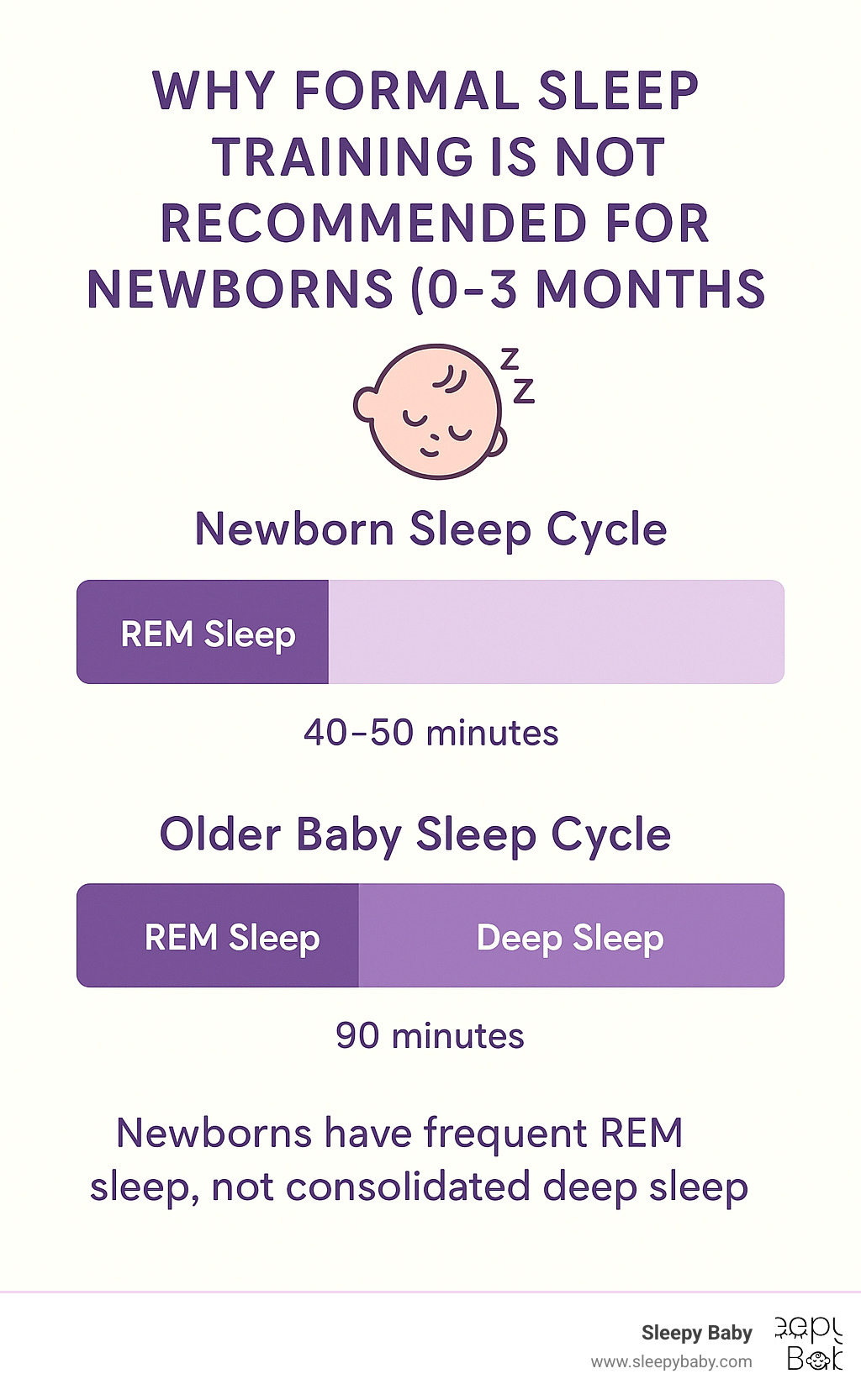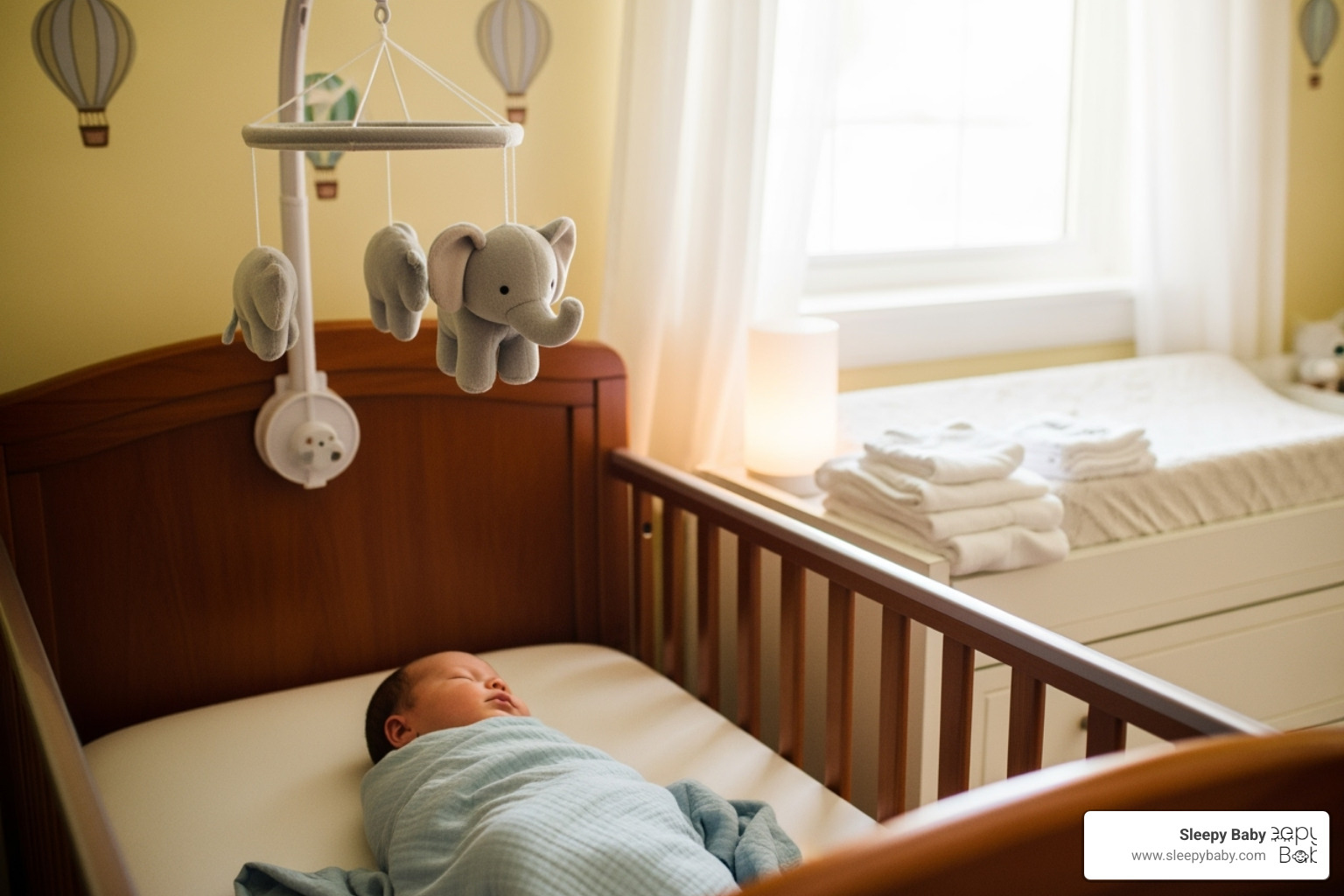The Truth About Sleep Training for Newborns
Sleep training for newborns is a top search for exhausted parents, but the truth is, formal methods like "cry it out" aren't suitable for babies under 4 months. However, you can start building healthy sleep habits from day one.
Quick Answer for Sleep Training Newborns:
- Formal sleep training: Not for babies 0-3 months old.
- What you can do: Build gentle sleep habits and routines.
- When to start formal training: 4-6 months, when developmentally ready.
- Focus for newborns: Positive sleep associations and responding to needs.
The newborn phase, or "fourth trimester," is about survival and trust. Your baby's sleep is still developing, and they need frequent feeding and comfort. Instead of formal training, think of it as sleep shaping—creating a foundation for healthy sleep later on.
Newborns can't be formally trained because they:
- Have underdeveloped circadian rhythms.
- Need to eat every 2-3 hours.
- Cannot self-soothe yet.
- Use crying as their primary communication.
I'm Gary Harutyunyan, a father who understands the desperation for sleep solutions. My experience led me to create the Sleepy Baby device, which provides gentle, rhythmic comfort that mimics a parent's touch to support healthy sleep development.

Why Formal Sleep Training is Not Recommended for Newborns (0-3 Months)
When you're exhausted, the idea of sleep training for newborns is tempting, but formal methods are not appropriate for babies under 4 months. A newborn isn't being difficult; they are simply not developmentally ready for the independence that sleep training requires.
- Newborns can't self-soothe. Their nervous systems are still maturing, and they don't have the brain wiring to calm themselves. Crying is their only way to communicate a need for hunger, comfort, or your presence.
- They need to eat frequently. A newborn's tiny stomach requires feeding every 2-3 hours around the clock for healthy growth. Stretching these intervals can interfere with weight gain.
- Their internal clocks are under construction. Newborns have not yet developed circadian rhythms, so day-night confusion is normal and temporary.
The American Academy of Pediatrics advises that responding to your newborn's needs builds trust and security. You cannot spoil a baby this young by comforting them. For more guidance, see Getting Your Baby to Sleep.

Understanding Newborn Sleep Patterns
Normal newborn sleep is 14-17 hours a day in short, unpredictable chunks. Their sleep cycles are only 40-50 minutes long, leading to more frequent waking. They also spend more time in light, active REM sleep, which is crucial for brain development but makes them easier to disturb. This is compounded by the fact that they don't produce the sleep hormone melatonin until 3-4 months and have a strong startle (Moro) reflex that can wake them up. This disorganized pattern is normal and necessary for their development. For a deeper dive, read our guide Dreamland: A Guide To Newborn Sleep Hours.
The Importance of Responding to Your Newborn
Crying is your newborn's primary communication tool for hunger, discomfort, or the need to feel safe. Responding consistently builds a secure attachment, teaching your baby that the world is a safe place where their needs are met. This isn't a bad habit; it's the foundation for emotional security. Research shows responsive parenting helps babies develop better self-regulation skills later. Your quick response to hunger and discomfort builds trust and can reduce crying over time. Learn more in The Calming Chronicles: Helping Your Infant Self Soothe.
A Realistic Approach to Sleep Training for Newborns: Building Healthy Habits
While formal sleep training for newborns is not an option, you can practice sleep shaping. This gentle approach focuses on creating positive sleep associations and consistent rhythms to build a foundation for healthy sleep. You're not forcing a schedule but creating an environment where good sleep can develop naturally. Learn more about these early patterns in From Sleepless Nights To Sweet Dreams: Establishing Newborn Sleep Patterns.
Key Strategies for the First 6 Weeks
This period is about bonding and survival. Here's a look at newborn sleep needs:
| Characteristic | Weeks 1-3 | Weeks 4-6 |
|---|---|---|
| Total Sleep (24 hrs) | 16-20 hours | 14-17 hours |
| Wake Windows | 30-60 minutes | 45-90 minutes |
| Nap Duration | 30-120 minutes | 30-120 minutes |
| Night Waking for Feeds | Every 2-3 hours | Every 2-4 hours |
- Ensure full feedings: A well-fed baby is a sleepy baby. Aim for complete feedings, not just snacks, to encourage longer sleep stretches.
- Swaddle snugly: Recreate the womb's security and tame the startle reflex with a snug swaddle.
- Use white noise: A consistent whooshing sound mimics the womb and masks household noises.
- Practice skin-to-skin: This contact helps regulate your baby's heart rate, breathing, and temperature, promoting calm.
- Watch for sleepy cues: Yawning, a glazed-over stare, or fussiness are signs to start the sleep routine immediately to avoid an overtired baby. Explore more in How To Master Infant Calming Techniques In 30 Days.
Helping Your Newborn Distinguish Day from Night
Teach your baby the difference between day and night. During the day, accept bright light and normal household noise. At night, shift to a calm, dark, and quiet environment. Keep nighttime interactions minimal and focused on needs, not play. A simple, consistent bedtime routine (e.g., bath, feeding, cuddles) signals that sleep is coming. Find more tips in Routine Magic: Creating A Newborn Schedule For Success.
Gentle Techniques for Encouraging Independent Sleep
The goal is to help your baby learn to fall asleep in their own space.
- Use the "drowsy but awake" method: Place your baby in their crib while they are sleepy but still conscious.
- Pause before intervening: Give your baby a moment to settle on their own before stepping in.
- Try in-crib soothing: Use a gentle hand on their chest or the shush-pat technique (loud shushing and rhythmic patting) to offer comfort without picking them up.
- Comfort and put down: If you do pick them up, soothe them until calm, then place them back in the crib before they fall asleep.
Soothing tools like the Sleepy Baby device can be a great help here. It provides rhythmic patting and white noise that mimics a caregiver's touch, offering consistent, hands-free comfort that supports the "drowsy but awake" method and helps your baby feel secure as they learn to fall asleep independently.
Navigating Common Newborn Sleep Problems
Even with a solid foundation, common issues like gas, reflux, and colic can disrupt sleep. These challenges are normal, and there are gentle ways to help your baby through them. Gas and fussiness are frequent culprits as your baby's digestive system matures. Reflux, where stomach contents come back up, can also be painful when lying flat. Colic is defined as intense crying for more than three hours a day, at least three days a week, often related to digestive discomfort or an immature nervous system.

Soothing Gas and Reflux for Better Sleep
Practical strategies can make a real difference for digestive discomfort.
- Burp frequently: Burp your baby during and after feeds in various positions.
- Try gentle movements: Bicycle legs and supervised tummy time can help release trapped gas.
- Keep baby upright after feeds: Hold your baby upright for 20-30 minutes after feeding to help with reflux.
For more strategies, see our Newborn Gas Relief Guide: Helping Your Little One Feel Better Fast. Always talk to a pediatrician if symptoms are severe or cause significant distress.
Coping with Colic and Overtiredness
Colic is temporary, and proven strategies can help. The 5 S's (Swaddling, Side/Stomach position, Shushing, Swinging, Sucking) trigger a baby's calming reflex. Our Sleepy Baby device incorporates rhythmic patting and white noise to mimic these comforting sensations, offering hands-free help during intense periods. Learn more about Implementing the 5 S's.
Preventing an overtired cycle is also crucial. Watch wake windows carefully (newborns shouldn't be awake longer than 1-2 hours) and act on sleepy cues quickly to prevent meltdowns. Colic typically peaks around 6 weeks and resolves by 3-4 months. For more support, visit The Ultimate Guide To Soothing A Colicky Baby Without Losing Your Mind.
When to Start Formal Sleep Training (And Why It's Worth the Wait)
The right time for formal sleep training is typically between 4 to 6 months of age, based on developmental readiness. Around this time, several key developments make sleep training safer and more effective. Your baby's circadian rhythms mature, they start producing melatonin, their sleep cycles become more organized, and they begin to show early self-soothing skills like sucking on their hands.
By 4-6 months, many babies can sleep for six to eight hours overnight without a feed (with pediatrician approval). Research from the American Academy of Pediatrics confirms that behavioral sleep training is safe and effective from this age, with no evidence of long-term negative effects. You can read more in this Five-Year Follow-up of Harms and Benefits of Behavioral Infant Sleep Intervention: Randomized Trial. To learn more about this milestone, explore Opening Up The Mystery: When Do Babies Sleep Through The Night.
Signs Your Baby is Ready for Sleep Training
Look for these green lights that your baby is ready:
- Consistent weight gain and your pediatrician's approval to reduce night feeds.
- At least 4 months old.
- Showing signs of self-soothing, like sucking on their hands.
- Longer, more consistent awake periods during the day.
- More predictable sleep patterns are emerging.
A Quick Look at Formal Sleep Training Methods
Once your baby is ready, choose a method that feels right for your family and stick with it consistently for at least two weeks. A consistent 30-45 minute bedtime routine is key to any method's success. Common approaches include:
- Cry It Out (Extinction): Allowing the baby to cry until they fall asleep without intervention.
- Ferber Method (Graduated Extinction): Checking on your baby at gradually increasing intervals with brief reassurance.
- Chair Method: Sitting by the crib and moving your chair further away each night.
- Bedtime Fading: Adjusting bedtime to align with your baby's natural sleep rhythm.
- Pick Up, Put Down: Picking up your baby to calm them when they cry, then putting them back down once calm, repeating as needed.
The Sleepy Baby device can be a powerful tool during gentle sleep training. Its rhythmic patting and white noise provide a familiar, soothing sensation as you reduce your hands-on intervention, helping your baby feel comforted as they learn to self-soothe. Learn more in Do Baby Sleep Trainer Devices Actually Work? Let's Find Out.
How Parents Can Cope with Sleep Deprivation
The newborn phase is a marathon run on very little sleep. Surviving the exhaustion is a universal challenge for new parents. Prioritizing your own rest isn't selfish—it's essential for your well-being and your ability to care for your baby. You cannot pour from an empty cup. Managing your physical and emotional health is crucial during this temporary but intense phase.

Practical Survival Tips
Here's how to steer the sleep-deprived newborn phase:
- Sleep when the baby sleeps: This is the golden rule. Forget the housework and prioritize even a short nap. It can make a world of difference.
- Take shifts with a partner: If possible, divide the night so each parent gets a longer, uninterrupted stretch of sleep.
- Accept help: When family and friends offer to help with meals, chores, or watching the baby, say yes. It's smart parenting, not a sign of weakness.
- Lower household expectations: A spotless house is not the priority. Rest, your baby, and your own basic needs come first.
- Stay hydrated and nourished: Keep water and easy-to-grab, healthy snacks nearby to combat fatigue.
- Prioritize your mental health: The newborn phase is emotionally challenging. Talk to your partner, friends, or a professional if you feel overwhelmed. It's common to struggle, and support is available.
For more strategies, check out Overcoming Colic And Sleep Deprivation In Newborns: A Journey To Colic Relief.
Conclusion
So, can you really sleep train a newborn? The answer is no, not with formal methods. We've found that for babies under 4 months, the focus should be on sleep shaping—building a foundation for healthy habits. The newborn phase is about responding to your baby's needs for food, comfort, and security. Their frequent waking and disorganized sleep are normal and necessary for their development.
Every time you respond with patience, you build trust, not bad habits. Gentle strategies like distinguishing day from night, ensuring full feeds, and practicing the "drowsy but awake" method are the building blocks for future sleep success. Remember on tough nights: this phase is temporary. Around 4-6 months, your baby will be developmentally ready for more independence, and longer sleep stretches will become possible.
Be gentle with yourself during this "fourth trimester." Every small step is an investment. Tools like the Sleepy Baby device can be a game-changer, mimicking a caregiver's touch with rhythmic patting and white noise. It provides the consistent, hands-free comfort your baby craves, supporting the "drowsy but awake" method and helping soothe fussiness or colic.
You are doing an amazing job. Trust the process and your instincts. For additional support, explore our guide: Find products to help soothe your colicky baby.





